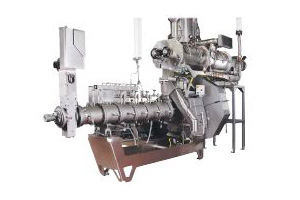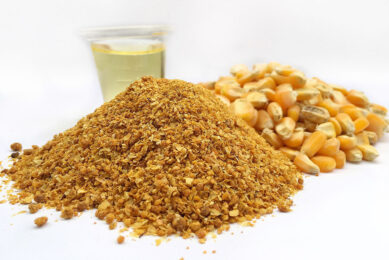Extrusion temperature: A critical control point in pet food processing

The cooking extrusion process, specifically extrusion ?temperature, is often chosen as a critical control point in food safety HACCP programmes. Many reports describe thermal ?treatments and their effectiveness, however, no scientific ?publications exist that demonstrate the correlation of pet food extrusion temperature with control and reduction of Salmonella or a suitable surrogate. Results of recent studies indicate a ?correlation between extrusion temperature and moisture and the destruction of pathogenic organisms in an inoculated pet food recipe.
By Galen J. Rokey, process technology manager, and Doug Baldwin, director of business development, Wenger Manufacturing
Pet food safety is critical not only because it is the law but is also the responsibility of the pet food manufacturer to maintain a safe food supply. The cost of producing safe products is increasing; however the incremental cost is small compared to the value of one individual becoming ill or dying due to unsafe food or handling practices. A good pet food safety programme can serve benefits including:
1) Reduced risks
2) Decreased waste, shrinkage, and customer complaints
3) Product traceability
4) Lower product liability
5) Transparency for consumer
6) Hard-won brand value
One major potential biological hazard that has been identified in the pet food production process is microbial contamination – specifically from Salmonella . Of the 229 primary contamination sources (industry and regulatory), Salmonella was counted as the most common hazard source ( Figure 1 ).
Specific best practices and guidelines for Salmonella control will be different for each plant, equipment and product. However, there are some specific areas of focus that will be common to all manufacturers. A critical control point (CCP) is implemented in a food safety programme to reduce the specific hazard of Salmonella . Extrusion is the major thermal process used in 95% of all pet food production and extrusion temperature is often chosen as a CCP. There are many studies on the use of extrusion cooking to reduce microbial counts, but few publications regarding pet food processing.
In reviewing practical Salmonella control measures in animal feeds, Jones identified three Salmonella control principles:
1) Prevent contamination from entering the facility
2) Reduce microbial multiplication in the plant
3) Kill bacterial populations
Hurdle technology is another practice to reduce and control Salmonella hazards. Although the normal levels of Salmonella contamination has been associated with elevated levels of indicator organism like Enterbacteriaceae. Fats tend to protect Salmonella from environmental and physiological stresses. Higher moisture content in the environment stimulates population growth. Temperature, time, moisture, and shear are the major processing functions associated with lethality although pressure has to be also considered. Many manufacturers extend preconditioning times in an effort to overcome poor mixing in their preconditioning operation and to enhance destruction. Organic acids are occasionally used in recipes and sanitation steps but these are costly, corrosive, and can have adverse effects on production workers, palatability, and vitamin stability.
Validation
In order to prove the effectiveness of the selected control measure, a validation step is required by HACCP programmes. Once the validation step has been defined, the extrusion temperature must be monitored to verify that they are actually achieved in production.
There are various approaches to validate the control of the extrusion temperature.
1) Reference to literature, validation studies, and studies from industry or equipment manufacturers.
2) Scientifically valid experimental data that demonstrates adequacy of the control measure through appropriate log reduction of a specific pathogen by a specific process
3) Collection of data during operational plant conditions which may include the use of a suitable surrogate to determine the effectiveness of a CCP.
4) Mathematical and predictive modeling
Recent validation studies specific to pet food
Wenger begun his research in 1980 to determine the effectiveness of extrusion as a thermal process to pasteurise ground corn. The results indicate that typical extrusion parameters were effective in reducing and controlling certain microbial populations ( Figure 2 ).
Subsequent studies focused on the impact of a steam preconditioning step as a process control measure. Steam preconditioning is an integral part of the extruded pet food process and continuously blends steam and water with raw, dry pet food recipes prior to extrusion. Coupled with extrusion cooking, preconditioning can provide additional protection as “hurdle technology” in a multiple hazard reduction step.
In 2011, microbial challenge studies using extrusion were conducted at the Bio-Safety Level II Laboratory in the University of Nebraska. Figure 3 summarises the survival of both a Salmonella cocktail and Enterococcus faecium in pet food extrusion at 27.5% moisture. The study indicates that Enterococcus survives at slightly higher extrusion temperatures when compared to Salmonella This characteristic of being slightly more heat resistant makes Enterococcus a good choice as a surrogate for extrusion lethality studies.
Many other factors impact the heat resistance of Salmonella in pet food which are not covered in experimental variables, including the pH,
presence of competing organisms, certain food additives, proximate analysis, composition, processing history (including non-lethal heat shock), moisture/water activity and other attachment factors.
Pilot plant studies are desirable in:
1) Determining expected decontamination with different substrates;
2) Resistance of different microbial species to destruction under the same extrusion conditions; and
3) Variations in potential for decontamination among various extruders.
Necessary revalidation of conditions include presence of new pathogens, extreme contamination levels, severe recipe changes, process parameters outside of the critical control limits, and changes in storage or packaging. The lingering problem of how to treat retention time in the extrusion thermal processing continues.
Evaluating extrusion as a thermal process with sufficient mixing and temperature in order to achieve a D-value of one second may be an interesting consideration.
Accurate measurement of extrusion temperature
When extrusion temperature is chosen as a process CCP for the control of Salmonella hazards, it is important to accurately measure and control product temperature.
A series of tests was conducted at Wenger to determine the impact of temperature sensor location and mounting techniques on the accurate measurement of product temperature. Actual product temperature was less influenced by environmental and other process factors when this measurement was taken in the die cavity after the screw element and before the final die assembly. Temperature along the extruder barrel was measured at the highest level in the extrusion process. A cross section of the mass of material in the die cavity can display a flow gradient with higher product velocities in the center of the flow and lower velocities along the die cavity wall.
Occasionally the product flow at the wall of the die cavity can be so low that it may appear to be totally stagnant. It is important to extend the temperature sensor at least 20 mm into the product flow from the side wall of the die cavity to avoid false product temperature readings in the stagnant or low velocity zones.
Extended tip temperature sensors are subject to abrasive wear from product passing through the die cavity and are often protected by metal sheaths. It is advisable to install two temperature sensors in this location, at 180 degrees from each other.
Product
temperatures can be displayed where they are readily available for production personnel.
The process control systems can be configured to alarm when process
temperatures drop below the critical limits. Advanced control systems not only monitor and record the extrusion temperature, but can also automatically divert product from the process flow when the temperature is below the critical limit.
AllAboutFeed volume 21 Issue 5
Join 26,000+ subscribers
Subscribe to our newsletter to stay updated about all the need-to-know content in the feed sector, three times a week. Beheer
Beheer









 WP Admin
WP Admin  Bewerk bericht
Bewerk bericht